Discovering Colorado's Trails: A Dirtbike Adventure
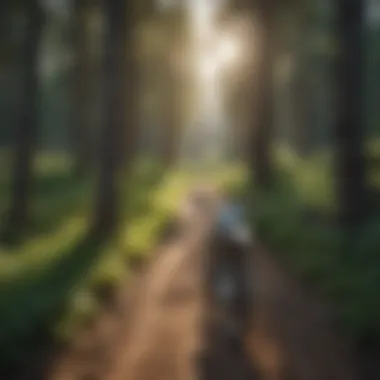
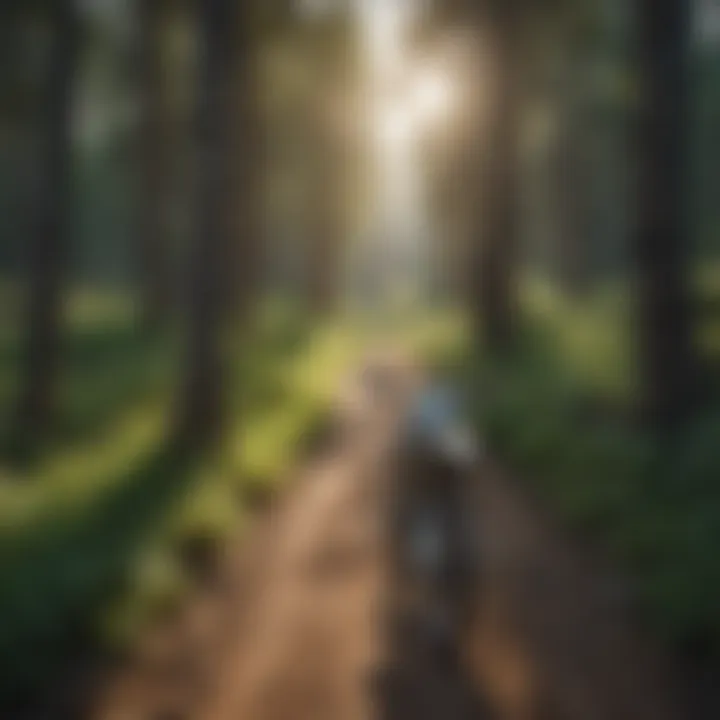
Intro
As we gear up to explore the dirtbike trails in Colorado, it's essential to look beyond just the thrill of the ride. The state is a treasure trove of diverse landscapes—all waiting to be discovered by enthusiasts. With a mix of mountains, forests, and open spaces, Colorado offers trails that cater to various skill levels, from beginners to experienced riders.
The intrigue of these trails isn't just in the adrenaline rush; it's about intertwining adventure with a deeper respect for nature. From the rugged highlands of the Rockies to the serene meadows of the foothills, each trail tells a story of the land and the ecosystems it supports. It's a balancing act—enjoying the freedom of dirtbiking while acknowledging the vital responsibility of preserving these beautiful locations for future generations.
In the sections that follow, we'll delve into key aspects of Colorado's dirtbike trails. We'll break down the different types available, identify regional highlights, discuss best safety practices, and emphasize the importance of environmental considerations. You'll come to understand not only the sheer exhilaration of riding but also how to keep Colorado’s wild spaces thriving by riding responsibly. Buckle up; this adventure promises both excitement and enlightenment!
Prelude to Colorado Dirtbike Trails
Colorado boasts a rich tapestry of landscapes that cater to dirtbike enthusiasts of all skill levels. In exploring its dirtbike trails, one comes not only to appreciate the exhilaration of the ride but also to engage deeply with the diverse ecology, geology, and history of the region. The intertwining of recreation and nature creates an experience that is both thrilling and insightful. Furthermore, understanding the nuances of these trails allows riders to maximize enjoyment while fostering a culture of respect and responsibility.
Historical Context
The evolution of dirtbiking in Colorado traces back several decades and reflects a shift in perceptions regarding the relationship between land use and recreation. Originally, off-road vehicles faced scrutiny due to concerns about environmental impact. However, with advancements in sustainable practices, many riders now prioritize responsible trail usage. Historical narratives highlight the balance riders must strike: embracing freedom on a bike while acknowledging the responsibility for preserving the pristine surroundings. When exploring trails, veterans share tales of early riding days, expressing admiration for both technology and nature. Riders today often feel charged with the heritage of generations past and strive to honor that legacy through conservation efforts.
Trails as a Form of Recreation
Dirtbiking serves as more than mere adventure; it symbolizes a lifestyle rooted in exploration and community. The trails appeal to those seeking the thrill of speed as well as those yearning for solitude among the towering pines of the Rockies. Spending time on these trails fosters not just a love for the sport but a connection to the environment. Riders develop camaraderie, sharing advice and experiences, often resulting in lifelong friendships. This is evident at local meet-ups where enthusiasts trade stories, tips about gear, and routes that enhance the riding experience.
Moreover, the accessibility of these trails caters to various skill levels, from the beginner tackling easy singletrack paths to expert riders navigating challenging terrain. As a result, the trails function as an inclusive space, welcoming all who seek the thrill of two wheels on dirt. Whether gliding through fields of wildflowers or climbing steep gravel inclines, each ride remains unique and filled with potential for growth and connection.
"The joy of riding goes hand-in-hand with the understanding that we are custodians of the trails, our memories forever intertwined with the land we traverse."
Understanding the importance of these elements ensures a comprehensive appreciation of what Colorado's dirtbike trails offer. As we further explore the types of trails, popular regions, and considerations associated with this noble pursuit, it becomes clear this journey through Colorado’s landscapes is also a journey towards responsible outdoor recreation.
Types of Trails
Understanding the different types of trails in Colorado is essential for any dirtbike enthusiast. Each type offers unique experiences, catering to a wide range of skill levels and riding styles. In this section, we will delve into the significance of these trail categories and what they bring to the table for riders seeking adventure and connection with nature. Choosing the right type of trail can not only enhance your riding comfort but also allow you to explore the natural beauty Colorado has to offer, while enjoying a safe and delightful outdoor experience.
Singletrack Trails
Singletrack trails are often characterized by their narrowness, typically accommodating just one rider at a time. This presents a more intimate experience with the forest, as riders weave through trees and navigate rocky paths. These trails can vary widely in difficulty, from gentle slopes perfect for beginners to technical sections that require finely-tuned skills and precision.
The beauty of singletrack lies in its immersive nature. Riders get a chance to appreciate the surroundings up close, hear the rustle of leaves, and maybe even spot wildlife. The challenge of maneuvering through tight turns and elevation changes can sharpen one’s skills significantly, making it a favorite among experienced riders eager for a challenge. Furthermore, singletrack trails present less disruption to wildlife, making them a more environmentally friendly option compared to wider roads.
Technical Trails
When we talk about technical trails, we converse about the ultimate test for skilled riders. These trails often include challenging features such as steep climbs, drop-offs, boulders, and muddy sections that haven't been tamed by less fearless riders. Technical trails not only demand a mastery of riding technique but also the ability to read the terrain ahead.
For those looking to push their limits, technical trails offer both adrenaline rush and satisfaction as they navigate through obstacles while harnessing bike control. Mastering a particularly tricky section can instill a huge sense of accomplishment. However, it's important to acknowledge that technical trails might not be suitable for everyone. Riders should assess their capabilities honestly and select trails that reflect their skill levels to ensure a safe adventure.
Multi-Use Trails
Multi-use trails are designed for various outdoor activities, making them a versatile option for dirtbikers, hikers, and sometimes equestrians. These trails can be an excellent choice for groups with diverse interests, fostering a sense of community as they share the space. However, with multiple users comes the responsibility to respect the trail etiquette, ensuring a pleasant experience for all involved.
For dirtbikers, multi-use trails typically feature a wider path, making them easier to navigate with both speed and safety. Riders should be mindful of their surroundings, keeping an ear open to the sound of oncoming hikers or other cyclists. Engaging with fellow trail users can enhance the overall experience, as it provides a chance to share tips and potentially discover new trails.
In summary, understanding the different types of trails not only enhances the dirtbiking experience but also fosters a greater appreciation for Colorado's stunning natural landscapes. Selecting the right trail type allows riders to fully connect with nature while aligning with their skills and interests.
Popular Regions for Dirtbiking
When delving into the rich tapestry of Colorado's dirtbike trails, the significance of regional distinctions becomes clear. Each area boasts its own unique flavor, offering distinct landscapes, varying levels of difficulty, and unique features that cater to diverse riding preferences. From the rugged, hilly terrains in the north to the arid expanses in the south, will impact both the experience and safety of dirtbikers. Understanding these popular regions helps riders choose trails that not only match their skill levels but also enhance their appreciation for Colorado's natural beauty.
Northern Colorado

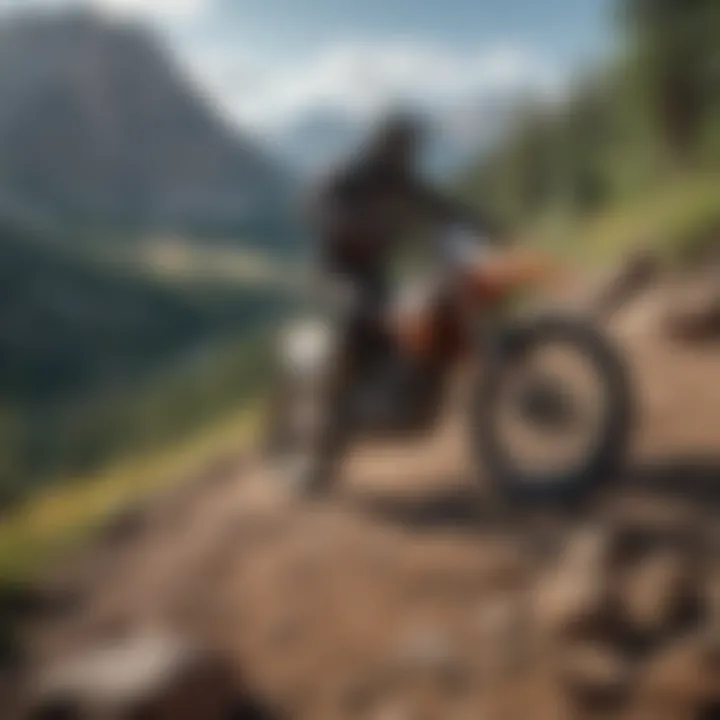
This region is like a hidden gem for dirtbike enthusiasts. It suffices to say that Northern Colorado has some of the most scenic and challenging trails in the entire state. Parks and foothills surrounding Fort Collins and the raw power of the Cache la Poudre River add to the adventure. Riders will find trails that wind through dense forests and rocky terrains, plus the fresh mountain air offers a breath of clearness that spices up the ride.
Some notable areas include:
- Masonville Trail System: Known for its singletrack routes, perfect for those who love a challenge.
- Horsetooth Mountain Open Space: Offers stunning views and a variety of trail types, suitable for intermediates to advanced riders.
- Red Feather Lakes: Combining beautiful lake views with rugged trails, this area can give riders a quick comparison of serenity and adrenaline.
The Northern Colorado region, with its varying altitudes and climates, calls for riders to be prepared for sudden changes in weather conditions throughout the ride, highlighting the need for flexibility in planning their outings.
Central Colorado
Moving to Central Colorado, the dirtbiking possibilities expand exponentially. This region is renowned for its incredible variety of trails that cater to both the novice and seasoned rider alike. The proximity of the Rockies, combined with captivating terrain, allows bikers to seamlessly switch from smooth, rolling hills to rocky climbs within a single outing.
Important spots here include:
- Rampart Range Road: A must-visit for trails that cater to all levels, providing a broad path and technical rock features.
- Quebec 2: You'll find singletrack sections that challenge any experienced rider while providing beautiful forest scenery.
- Breckenridge: Known for its majestic mountain setting, the trails around this area offer a perfect mix of nature and thrill.
What resonates strongly among riders is the community spirit that Central Colorado brings. Frequent local events and gatherings keep the passion for dirtbiking alive, promoting camaraderie and shared experiences among enthusiasts.
Southern Colorado
Southern Colorado embodies a different kind of thrill, where the geography transforms into awe-inspiring views and expansive valleys. This area stands out for its unique high desert landscapes that provide a thrilling contrast to the mountain trails found in the north and central regions.
Key locations include:
- The Colorado Springs Area: Home to Cheyenne Mountain State Park, which offers miles of multi-use trails amidst lovely vistas.
- Blanca Peak Trail: For those craving a more rugged adventure, this area is known for its steep inclines and breathtaking views.
- Great Sand Dunes National Park: Unusual for dirtbiking, but it allows riders to explore the area’s sandy trails for a unique experience.
Southern Colorado’s dirtbiking scenes often get overshadowed by its northern counterparts, yet it serves just as much beauty, temptation, and excitement. Including knowledge on local restrictions and environmental considerations here is crucial for maintaining sustainability while enjoying the trails.
"Exploring these diverse regions not only showcases Colorado’s stunning landscapes but highlights the need for responsible riding practices to preserve these treasures for future generations."
In summary, the popular regions for dirtbiking in Colorado each provide distinct advantages and challenges. Riders should carefully consider their options and experiences to make the most of their adventures.
Trail Conditions and Accessibility
Understanding trail conditions and accessibility is critical for anyone looking to navigate Colorado's dirtbike landscape. These aspects can make or break your riding experience and influence everything from safety to enjoyment. Let’s dive deeper into how trail conditions fluctuate and why accessibility matters.
Seasonal Variability
When we talk about seasonal variability, we're really touching on the fact that trail conditions shift dramatically with the changing weather. In winter, snow can blanket many trails, transforming a sunny path into a slippery slope of uncertainty. Early spring often brings muddy and rutted trails as snow melts, which might require riders to exercise a sensible amount of caution.
Conversely, the summer months open a window into prime conditions for dirtbiking. Trails are usually dry and clear, but things can get dusty. However, it's worth mentioning that the summer thunderstorms can lead to sudden flash floods that can wash away paths.
Here’s a quick glance at what to expect by season:
- Winter: Heavy snow and soft trail conditions; off-season for most.
- Spring: Muddy trails with potential rockfall; a time to tread lightly.
- Summer: Mostly dry but highly variable due to storms.
- Fall: Cool weather with possible early snow; a chance for stunning foliage views.
Whether you're a seasoned pro or just a weekend warrior, adjusting your riding plans to these seasonal shifts is paramount.
Weather Considerations
Weather plays an equally pivotal role in determining trail conditions. Rain, for instance, while at times refreshing for the flora, can turn trails into rivers of mud. A rainy day that precedes your riding plans can lead to unstable and treacherous terrains. A little sun can dry things out, but as mentioned, too much heat can create an environment filled with dust and loose debris. It’s a delicate balance between too much moisture and too little.
In the foothills and mountainous regions, weather can change in a heartbeat. One minute you could be enjoying a clear sky, and the next, a thunderstorm could roll in, leaving riders scrambling for cover. Riders are encouraged to check local weather maps and forecasts before heading out. Installing a weather app could save a lot of time and headaches.
Here are some essential takeaways on weather considerations before hitting the trails:
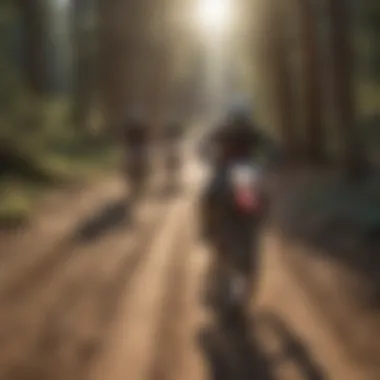

- Monitor Local Forecasts: Always keep your eyes peeled on weather apps that provide real-time updates.
- Recognize Local Patterns: Certain areas of Colorado may have specific weather tendencies. Get acquainted with these for a safer adventure.
- Have a Backup Plan: If the weather turns sour, know of alternate trails or nearby shelters to protect yourself.
"Riding in the wrong conditions may lead to accidents that can be easily avoided with a bit of foresight."
To sum it all up, understanding the fluid nature of trail conditions and the unpredictable patterns of Colorado weather is not just an afterthought—it's an essential part of responsible dirtbiking. Knowledge of these variables enhances enjoyment, safety, and longevity in the sport.
Safety Measures
Safety measures are crucial for anyone exploring the dirtbike trails of Colorado. The thrill of speeding through rugged terrains, coupled with the serenity of nature, makes it easy to forget about potential hazards. However, staying safe is not just about personal caution; it's about respecting the natural landscape and fellow riders.
Gear and Equipment
When it comes to gear, appropriate equipment is non-negotiable. Let's break down the essentials:
- Helmet: This is the most significant piece of protective gear. Without it, a rider leaves their head vulnerable. Look for helmets that meet safety standards, offering not just comfort but also reliability.
- Gloves: Riding gloves might seem trivial, but they improve grip on handles, ensuring better control of the bike. Furthermore, they protect hands from abrasions during a fall.
- Protective Clothing: A sturdy jacket and pants are essential. Materials like Kevlar can provide added protection against scrapes. Some riders opt for padded suits for that extra layer of safety.
- Boots: Specialized dirtbike boots support the ankles and provide grip while enhancing safety during rides.
Remember, it’s essential to fit these items properly. An ill-fitting helmet can do more harm than good.
Maintaining your dirtbike is another layer of safety. Regular checks on brakes, tires, and fluid levels can prevent mishaps on trails. Ensure your bike is in tip-top shape before every ride. As the saying goes, "An ounce of prevention is worth a pound of cure."
Trail Etiquette
Trail etiquette might not get the spotlight it deserves, but it plays a significant role in maintaining harmony on Colorado’s dirtbike paths. Riding with respect towards others creates a more enjoyable experience.
- Be Aware of Your Surroundings: Always keep an eye out for hikers or fellow bikers. Slow down when passing them. Remember, you share the trails, and safety is a two-way street.
- Yield When Necessary: If you see a fellow rider struggling or if someone is in distress, stop and offer help. This simple act of kindness goes a long way.
- Stay on Designated Trails: Straying off designated paths can damage ecosystems and disturb wildlife. Following marked trails minimizes environmental impact and ensures safety.
- Leave No Trace: Always take your trash home. This not only keeps the trails clean but also prevents animals from ingesting harmful materials.
"Respect the trail and it will respect you in return."
Understanding and adhering to these safety measures are imperative. They enhance not only the rider's experience but also contribute to the overall preservation of Colorado's beautiful landscapes. Riding thoughtfully ensures that future generations will also enjoy these magnificent trails.
Environmental Responsibility
In recent years, the relationship between outdoor recreation and ecological stewardship has grown increasingly important. When enthusiasts rev their engines on Colorado's dirtbike trails, they become part of a community that has a responsibility to safeguard the environment. This responsibility is not just a catchphrase; it embodies the actions and attitudes that enthusiasts adopt while navigating the diverse landscapes of the Rockies. Understanding the interplay between dirtbiking and environmental health is essential in ensuring that these precious trails can be enjoyed by future generations.
A significant part of this responsibility involves comprehending the ecosystem's fragility. Motorized activities can disturb wildlife, soil composition, and plant life. Hence, learning about the habitats through which these trails pass becomes vital. By grasping the delicate balance that nature holds, riders can take informed steps to minimize adverse impacts, contributing to an overall culture of respect for the land.
Protecting Wildlife
One of the most compelling reasons for dirtbikers to adopt environmentally responsible practices is the protection of local wildlife. Colorado is home to a plethora of species, from elk grazing in meadows to the elusive mountain lion. The noise and activity generated by dirtbikes may disrupt animal behavior, especially during sensitive periods such as mating and nesting.
To protect these creatures, riders can follow a few guidelines:
- Stay on Designated Trails: Straying off marked paths can damage habitats and cause erosion. Maintaining the integrity of the trails prevents disturbing animal territories.
- Educate Yourself on Local Species: Knowing what animals inhabit the area helps riders understand when they might encounter them, allowing for more mindful riding practices.
- Observe from a Distance: If you encounter wildlife, keep your distance. This not only protects the animals but also allows riders to enjoy a memorable experience.
"A responsible rider is not just a thrill-seeker; they are a steward of the land."
Minimizing Trail Impact
Minimizing trail impact is crucial for preserving the ecological balance of Colorado’s dirtbike trails. Each ride leaves a footprint, and without conscious effort, that footprint can lead to lasting damage. Riders can take simple yet effective measures to reduce their impact:
- Choose Appropriate Routes: Opt for trails designed for dirtbike use to limit damage to sensitive areas.
- Travel Light: Carry only essential gear and avoid overpacking. A lighter load reduces the amount of disturbance to trails.
- Stay Off Trails When Wet: Riding on muddy or saturated trails can lead to ruts and erosion. Giving trails time to dry preserves their condition.
- Join Clean-Up Initiatives: Participating in trail clean-ups fosters community spirit while protecting the environment. When enthusiasts unite for a cause, it showcases a commitment to maintaining trail integrity.
By integrating these practices into their riding routine, dirtbikers reflect a commitment to both their sport and the environment. Embracing environmental responsibility allows individuals to find harmony with nature, ensuring that Colorado's diverse dirtbike trails can continue to be a source of excitement and adventure for years to come.
Community and Events
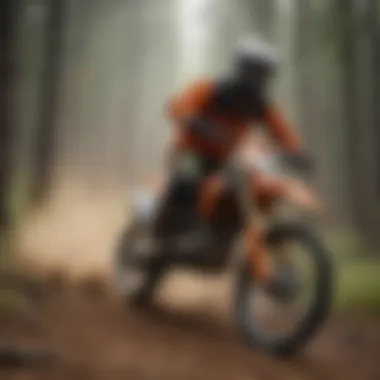

Understanding the community surrounding Colorado's dirtbike trails can greatly enhance the riding experience. It's not just about the stunning scenery or the thrill of the ride; it's about the shared passion that binds riders together. Being part of a local dirtbiking community provides both social interaction and a wealth of resources that benefit both new and experienced riders.
Local Clubs and Organizations
Many riders find camaraderie in local clubs that serve as the backbone of the dirtbiking community in Colorado. These clubs often organize regular group rides, workshops, and maintenance days. Whether you are a beginner or a seasoned pro, joining a local club can offer a significant boost to your riding skills and knowledge of the trails.
Some clubs focus on specific aspects, such as trail advocacy, ensuring vibrant discussions around environmental stewardship and trail access. Clubs like the Colorado Off-Highway Vehicle Coalition (COHVCO) actively lobby for rider rights and work with land managers to maintain trail integrity. By participating in these organizations, you not only ride but also contribute meaningfully to preserving the terrain for future generations.
Benefits of joining local clubs include:
- Networking Opportunities: Meet other passionate riders who can share their favorite trails and tips.
- Skill Development: Many clubs offer training sessions with experienced riders who share their expertise.
- Access to Facilities: Some clubs maintain dedicated areas for practice, making it easier to enhance your abilities.
- Advocacy Efforts: Clubs often work towards keeping trails open and sustainable, ensuring access for everyone.
Races and Competitions
Racing events bring a different flavor to the dirtbiking experience. Colorado hosts a variety of competitions throughout the year, ranging from enduro races to motocross events. These gatherings attract participants from all levels and allow riders to challenge themselves in a structured, yet fun, environment.
Participating in races may seem daunting at first, but they provide a unique opportunity to test one’s skills against others. Moreover, they foster a sense of achievement and community as riders cheer for each other regardless of their skill level.
Key considerations when participating in races include:
- Preparation: Ensure your bike is in top shape beforehand; nothing worse than a malfunction mid-race.
- Understanding Rules: Each competition has its own set of guidelines. Familiarizing yourself with these can save you headaches.
- Practice Runs: Before the actual race, practice is crucial. Familiarize yourself with the terrain and obstacles to minimize surprises on race day.
"The best part of any dirtbiking adventure is the people you meet along the way. They're the heart of the trails."
For more resources, consider checking out the local discussions on Reddit or visiting Facebook groups dedicated to dirtbike enthusiasts in Colorado.
Future of Dirtbiking in Colorado
The dirtbiking landscape in Colorado is constantly evolving, shaped by both local traditions and broader environmental changes. The future of this outdoor pursuit hinges on a variety of factors that are vital for enthusiasts to grasp. Understanding these elements will not only enhance the riding experience but also preserve the trails for generations to come.
Changing Regulations
As the popularity of dirtbiking grows, so too does the scrutiny surrounding it. New regulations emerge regularly, aimed at balancing recreational access with environmental stewardship. Keeping an eye on these changes is crucial for riders who want to stay compliant and informed.
Considerations include trail access limitations during sensitive times, like animal breeding seasons, or specific gear requirements to minimize trail damage and enhance safety. As community voices increasingly influence policy, it’s important for riders to engage with local governments and advocate for reasonable regulations that prioritize both recreation and conservation.
In addition to local policies, some federal guidelines are also changing to address environmental concerns. For instance, guidelines regarding emissions from vehicles and noise pollution may become stricter. Riders will need to be aware of these shifting landscapes to continue enjoying their favorite trails.
Sustainability Initiatives
Sustainability has become a buzzword in recreational circles, and dirtbiking is no exception. There are emerging initiatives to promote eco-friendly practices within the community. Local clubs and organizations often spearhead these efforts by educating members on best practices that minimize impact.
Some effective measures include:
- Tread Lightly Campaign: This initiative encourages riders to respect the land, ensuring they stay on designated trails to protect the surrounding ecosystem.
- Trail Clean-Up Events: Participating in these helps maintain the trails while building camaraderie among the dirtbiking community.
- Sustainable Vehicle Options: The push for electric dirtbikes is gaining ground, with several manufacturers releasing models aimed at reducing the carbon footprint of this sport.
"Promoting responsible dirtbiking means ensuring our favorite trails remain accessible for everyone. Together, we can make our trails thrive."
As initiatives evolve, it’s imperative for the dirtbiking community to embrace these changes. Adapting to sustainability practices not only enhances the sport but also enriches the natural environments that riders cherish.
In summary, the future of dirtbiking in Colorado is a tapestry woven from regulatory changes and sustainability efforts. By staying informed and engaged, riders can ensure they contribute positively to this dynamic landscape, making each ride a meaningful experience.
Closure
Exploring the intricate world of Colorado's dirtbike trails is essential, as it allows riders to connect with nature while indulging in their passion for off-road biking. This article has traversed through numerous facets of these trails, demonstrating not just their diversity but also their significance in fostering an outdoor culture. Understanding the types of trails available encourages riders to select the best suited for their skill levels and preferences, enhancing their overall experience.
Key Takeaways
- Trail Diversity: Colorado boasts a vast array of trails, including technical, singletrack, and multi-use options that cater to various skills and desires. Riders can choose based on their abilities, ensuring safe and enjoyable experiences.
- Environmental stewardship is a crucial aspect. Our trails traverse sensitive ecosystems. Thus, it's vital for riders to practice good trail etiquette and minimize their environmental impact. Everyone can contribute to preserving Colorado’s natural beauty for future generations.
- Safety preparations are paramount. Using appropriate gear and understanding the trail layout can make all the difference in ensuring a safe ride. Briefing oneself about weather conditions also plays a significant role.
- Community engagement enhances the journey. Local clubs and events offer opportunities not just to ride, but also to meet like-minded individuals, share knowledge, and contribute to trail maintenance efforts.
Encouragement for Responsible Enjoyment
Riding in the breathtaking terrains of Colorado should be a source of joy and discovery, but it is equally vital to embrace responsible enjoyment. Riders should approach each trail with respect, acknowledging that these paths are shared spaces meant for everyone’s enjoyment.
- Always follow established trail rules and regulations. Understanding and adhering to specific guidelines protects both riders and the environment.
- Practice Leave No Trace principles by ensuring that you pack out what you pack in, and refrain from disturbing wildlife or damaging vegetation.
- Lastly, participating in local trail clean-up events or becoming involved with advocacy groups can greatly enhance your riding experience while contributing positively to the dirtbiking community.
By adopting a responsible mindset and a commitment to preserving the landscape, riders can ensure that Colorado’s diverse dirtbike trails remain a cherished resource for years to come.



